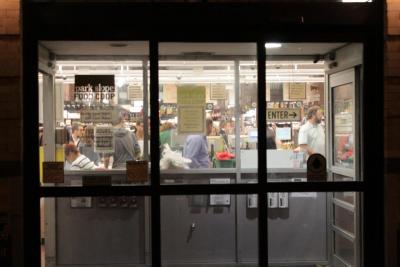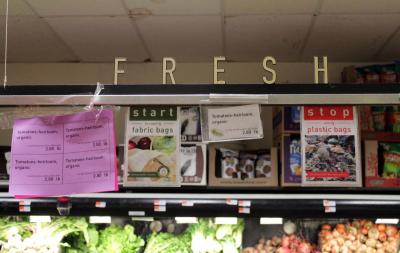
The first Honeycrisp of the year carries more significance than any piece of fruit should. Its annual appearance in September’s produce aisle—a brindled globe of green, yellow, and red—is still a shock to me. Shelves on each side are stocked with plastic cartons of withering raspberries and the last crate of pluots, still summer-sweet but invariably mushy-bottomed. The lustre of summer is spent. The bin of Honeycrisp apples—peeking out from beneath the words, “NEW CROP” — announces that fall is on our doorstep.
My relationship with produce was hardly this involved when I was a child, mostly because the supermarkets of Southern California were nothing like Brooklyn’s Park Slope Food Coop, where I’ve been grocery shopping for the last two years. On a hilly strip of Los Angeles that rarely tilted away from the sun, I spent seventeen years staring at fixed mountains of Red Delicious apples without a second thought, barely noticing the change of seasons. The suburban supermarket was a place of order, sterility, and the promise that everything edible would be packaged and stocked on the correct shelf for eternity.
The Park Slope Food Cooperative, a member-run grocery store nine blocks from my brownstone apartment building, is the antithesis of that supermarket. Founded in 1973 with a membership of 10, the Coop will have over 16,000 members on its 40th anniversary next year—every one of whom is required to work one shift at the Coop every four weeks. The penalty for missing that 2-hour-and-45-minute shift is two make-up shifts. The next strike results in suspension of membership.
The rigidity of this golden rule makes a nice perch for lampoon. Media headlines like “Flunking Out at the Park Slope Food Coop” and “Won’t Work for Food” wrap miles of copy around the experience of shopping at a gated grocery, governed by as many rules as the floors of Congress. Members are expected to count family members as workers, to prevent one work shift from benefiting an entire household. No one can enter the store without scanning his membership card. The store didn’t accept payment by debit card until 2007, and shoppers wait in up to three lines—one to check out, a second to pay with cash, and a third to have receipts marked—to s successfully leave the store. Fittingly, the name of the Coop’s bi-weekly newsletter is The Linewaiters’ Gazette.

This list of inconveniences goes on, fueling the fire lit by newspapers, blogs, and The Daily Show. The public image of the Coop—a tangle of bureaucracy and snobbery—is burnished in the way the store elevates (and complicates)ethicalelevatef the act of everyday consumption. The Coop openly aims to improve the quality of life through food, prioritizing toxin-free goods and refusing suppliers whose practices are deemed unethical or environmentally unsound. Rooted in an ideal of egalitarian ownership, the organization also strives to base purchases and policies on direct input from members. If the Coop’s tenets place the organization on stereotypical grounds, then the committees, agendas, and meetings set up to enforce those tenets erect a messy shrine to democracy that begs the outside world for punch lines.
Consequently, news writers have pecked at the quirks of a grocery store where Coca-Cola is banned and where the decision to carry beer for the first time required several months of deliberation. The most high-profile issue of the decade, a proposal for the Coop to boycott Israeli-made products, culminated in a vote on whether or not to hold a vote. Members ultimately rejected the idea of even carrying out a referendum on the goods (and political stance) in question, but the intensity of the proposition rang louder than its result. After the dust had settled, city historians could add headlines like “Inside the Epic Park Slope Food Co-Op ‘Boycott Israel’ Circus” to a scrapbook containing such greats as “Co-op Chaos: Park Slope Scrambles for Seaweed Amid Nuclear Fears” and “Park Slope Food Co-op Says, ‘H2NO!’”
Yet, even as reporters and bloggers swoop down to cover the Coop’s culture wars, business writers have highlighted a more astonishing fact: its enormous purse. As it turns out, half-socialist, half-corporatist rules have made the Park Slope Food Coop an economic powerhouse.
Whereas the national average of sales per square foot in a for-profit supermarket was $647.90 in 2011, the same figure for the Coop was close to $7,000. This implies that, in sum, the Coop takes in 900% more cash per square foot than a typical Safeway or Kroger. When compared to Trader Joe’s, the store still moves almost four times the goods, with less floor space. Criticisms and public image notwithstanding, the Coop does business hand over fist, turning over its inventory more than 65 times a year.
The economic heart of the Coop is its declared mission to be “a buying agent for our members and not a selling agent for any industry.” Even if the moral sentiment means nothing to a member, the accompanying discounts on everything from farm-fresh produce to seltzer machines are enough to inspire loyalty. In requiring members to contribute most of its labor, the Coop does away with one of a grocery store’s biggest costs; in leveraging the demand of thousands of shoppers to negotiate bulk deals from suppliers, it slashes down another. Every aspect of the operation is data-mined via inventory and powered by a well of institutional knowledge; members rely on experience more than automation to run the store with a rich understanding of how their work impacts the flow of the store. Side-stepping high markup rates, the Coop’s focus on high quality, minimal markup, and demand-driven purchasing allows it to make millions while saving millions.
Transforming profit into savings, the Coop also invests in longevity. Full-time employees are paid a full salary, with benefits. The store’s childcare center is open to both workers and shoppers. And members are welcome to hold film screenings, teach-ins, and other community events in the store’s meeting rooms. A sense of history pervades each room in the building, and a sense of continuous action fills each work shift, often guided by coordinators who have been members for years. At the end of every 18-hour day, the Coop is less a command-economy cult than a ramshackle Rube Goldberg machine, perpetuating the movement of rainbow chard at a breakneck pace.
Every fourth Wednesday, I become a cog in that machine. As a member of the Stocking and Receiving Committee, I find myself turning gears in all corners of the store, but my shift always starts with a smile from Karen. A single mother and one of the Coop’s few full-time employees, she signs me in at the store’s receiving garage. Then, scribbling on a legal pad, she charts a list of tasks and begins asking for volunteers.
I often head to the basement, to slide boxes, jars, and cans along manual conveyor belts or load up rickety steel “U-Boats” with goods to be sent up the lift. The next moment I’ll be on the main floor, rolling organic broccoli into bins or filling canisters with coffee beans and wild rice. Each shift includes trips to the cardboard compactor, where comrade Rob breaks down boxes and engages me in chat about Game of Thrones. Every so often I’m plopped in front of a scale, beside the doo-ragged cheese cutters, to weigh and sticker cuts of raw meat.
Between tasks I run to the member-cleaned bathroom and drink from a water fountain just outside Coop child care, where I discovered that the guitarist from the Roots spends his 2 hours and 45 minutes playing with toddlers. When I’m lucky I’ll find myself in the produce fridge with Gabriel, a dreadlocked resident of Brooklyn’s West Indies who, unfailingly cheery and literally singing the praises of Haile Sallasie I, seems to fit every stereotype I’ve ever been exposed to regarding the Jamaican spirit. Sometimes I think to myself: This must be what geocaching feels like.
The Coop may not be a place of order, but it runs on the guarantee that every action has a clear result. To a man who spends 15 hours a day staring into a computer screen, constantly questioning the point of my day job and wondering where freelance food writing is leading me, the tasks of a stock boy at the Coop offer some of the most grounded, satisfying work I’ve ever done: I can always see the fruits (and vegetables, and wild rice) of my own work shift.
Just as the Brooklyn neighborhood of Williamsburg has become synonymous with the projectile pronounced “hipster,” Park Slope is often equated to the pairing of stroller and lesbian—shorthand for gentrification and liberalism. Neighborhood food culture in particular has shifted over the past few decades, from working-class to gourmet, on nearly every corner. But my shift at the Coop—where New Yorkers who will never see six figures in the green can afford to buy farmer’s market vegetables once a week—belies the boutique Brooklyn that’s filled out the neighborhood. Once inside, I bump elbows with people from up and down the income spectrum: Hasidic Jews, fixed-income seniors, yuppie couples, parents on food stamps, journalists, middle managers, Ukrainian grandmothers, lesbians, strollers, and school-grade children who’ve tasted more types of kale than I have.
In a snapshot, the Coop resembles organically certified pandemonium. In motion, it’s more like an ant farm. For every other shopper plumbing boxes of heirloom tomatoes, there’s a member on her shift, wheeling out goods from the lift and onto the floor. Walking in a straight line is an endeavor best stowed at the back of one’s mind: no aisle is ever clear, and no conversation private. Workers are likely to ask the shoppers about what goes where, and shoppers are likely to ask workers if they’ve ever tasted the soy milk they’re about to put on the shelves.
Though the breadth of the Coop’s inventory is modest, the food itself is often magnetic. Shipments of tiny, long-stemmed, farm-fresh strawberries vanish in hours, and unfamiliar fruit selections are often accompanied by hand-written notes describing their taste and origin. Palm-sized baggies of bulk-bought nutmeg, tea leaves, dried cherries, and chocolate-covered ginger are sealed by twist-tie and sold for pennies on the dollar. Pints of ice cream from three local parlors fill the freezer at a 15% discount. Should one wonder when the next shipment of pasture-raised lamb chops is due, or how in the hell one might cook a pound of West Indian Gherkins, the Coop’s store-wide intercom is offered to any member as an analog to Google. When one member picks up the com to crowd-source her question, it doesn’t take more than a few moments for another to pick up and offer an answer.

During peak hours, members navigate seven crowded lanes and line up to pay for their goods. It’s usually a friendly, communal wait, wherein debates over divestment are rare, but impulsive purchases of gourmet chocolate just before checkout (on my part, at least) are not. A cooperative grocery store has the stuff of life— disheveled and eccentric, daring to break the industrial promise of order, more organism than organized.
After my shift, I pull groceries out of my backpack and find places for them in my kitchen, setting aside one Honeycrisp before closing the refrigerator door. Then, I wash the apple and take a bite. I don’t really need a piece of fruit to tell me that it’s time to put on a coat or contemplate a weekend in New England. But the taste of a Honeycrisp is a refreshing reminder of how affecting food can be when it’s given a home. As the weeks pass, new crops—Galas, Winesaps, Empires, Braeburns, Pink Ladies, and Candycrisps—will fill out bins of their own. A small fortune of butternut squash will spill into the aisles at the Park Slope Food Coop. The breeze will cool, and leaves will litter the sidewalks, as fall comes into full bloom in Brooklyn.
James Boo is a freelance writer and photographer specializing in food, and works as a project manager for Knewton, a technology start-up that’s raised millions of dollars but zero honeycrisp apples.
Photos by James Boo



